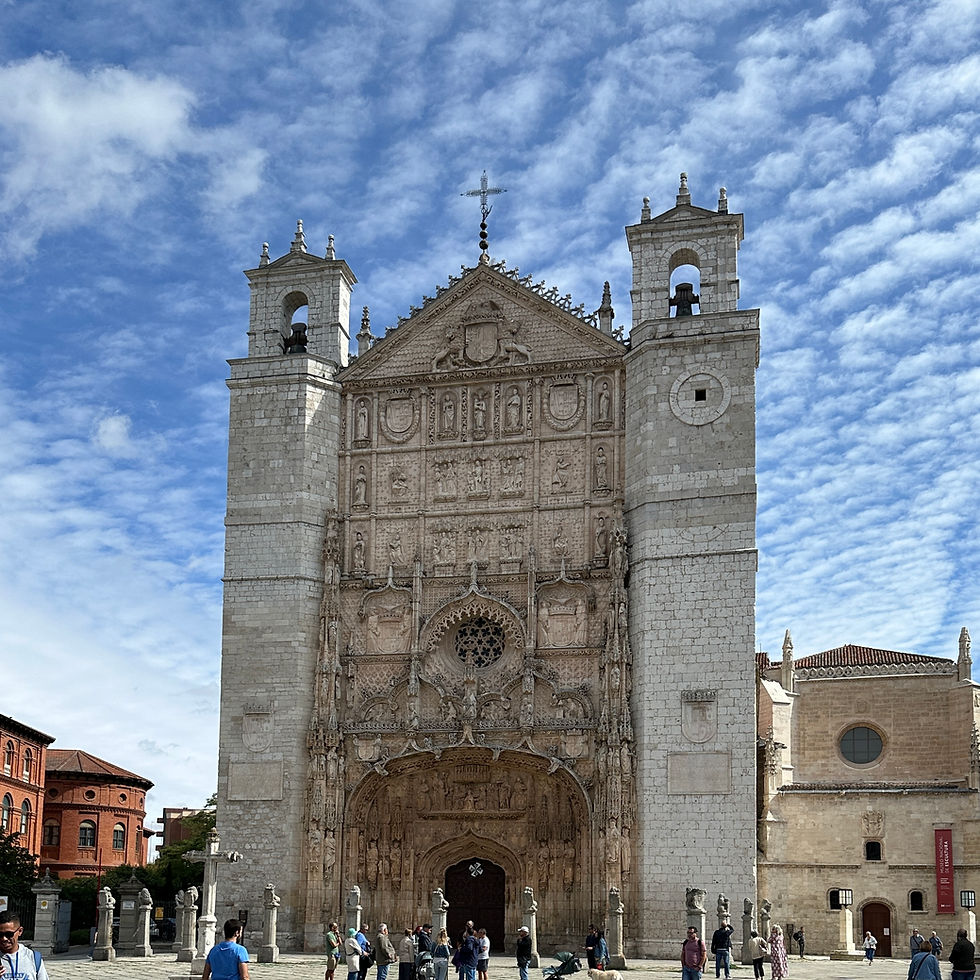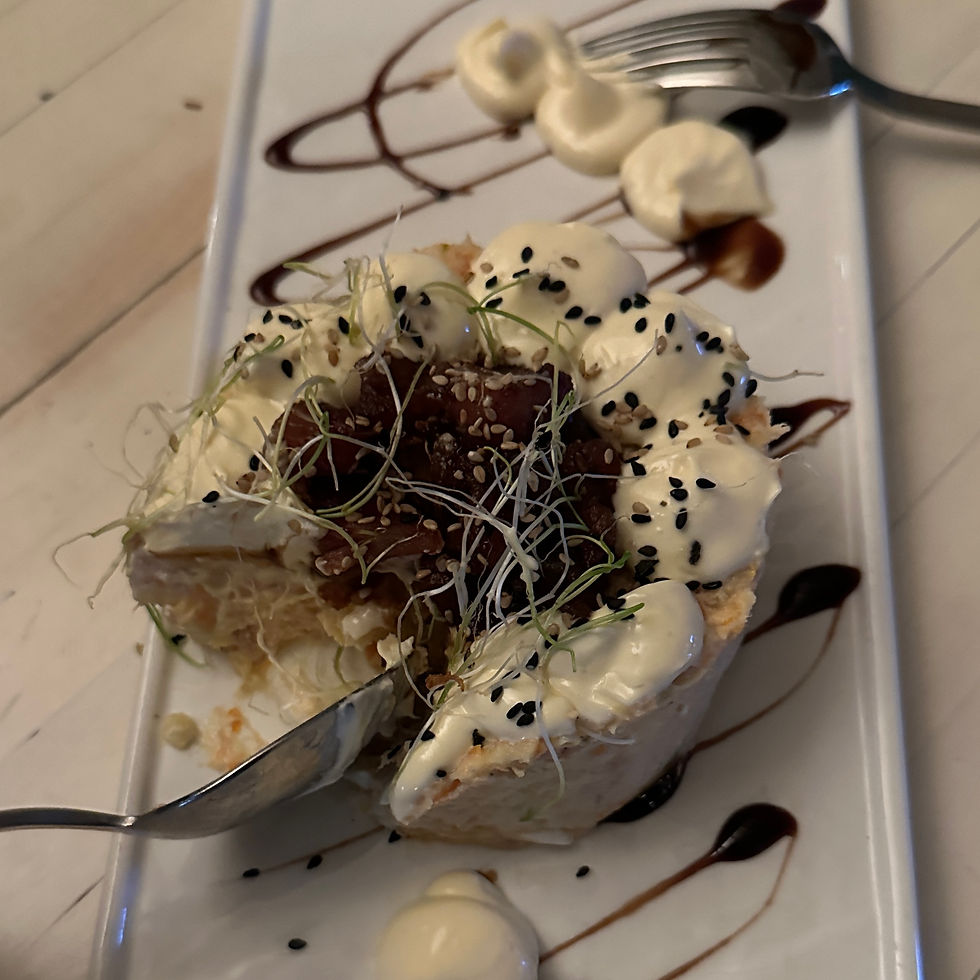Valladolid, Spain! Orientation and Travel Guide
- Charles Jordan
- Dec 30, 2024
- 11 min read
Updated: Aug 1

Valladolid: Overview and Historical Context
We recently visited Valladolid, Spain, located about a two hour drive north of Madrid in the Autonomous Community of Castilla y León. The city’s name is a derivation of the Moorish city name Belad Ulid which had been established here. We asked Microsoft CoPilot for the meaning of Belad Ulid (on December 29, 2024). Apparently it translates to "City of the Walled Place" or "Fortified City," reflecting the historical significance and strategic importance of Valladolid during the Moorish occupation of the Iberian Peninsula. This sounds reasonable to us and we couldn't find the translation on our own. So, we'll take it!
Valladolid is a small university city with plenty of culture, history, interesting museums, beautiful architecture, delicious cuisine, and more. If you enjoy wine, the nearby Ribera del Duero and Rueda wine countries have wineries, hotels, and spas for you to enjoy. With just over 300,000 citizens, it's the tenth largest city of Spain, similar to the population of Córdoba and less than half the population of Sevilla. So, it has more of a small city feel than larger cities like Barcelona and Madrid. US cities with a similar population include Cincinnati, Ohio, Pittsburgh, Pennsylvania, Durham, North Carolina.
As you'll read later in our section about the Valladolid Museum, there is archeological evidence dating all the way back to Paleolithic times. And it's university, one of the oldest in the world and still providing higher education today, was founded in 1241, in the latter part of the middle ages. (Wikipedia, downloaded on December 27, 2024)
The Capital of Spain, Briefly
An article published by La Vanguardia (downloaded on December 27, 2024) discusses the historical period when Valladolid served as the capital of Spain from 1601 to 1606. Just 40 years after Madrid was established as the capital of Spain, the Duke of Lerma, who was the chief minister of King Philip III, orchestrated its move to Valladolid. Lerma convinced the king to relocate the capital from Madrid to Valladolid, citing reasons such as activating the economy of northern Castile and escaping the perceived unsanitary conditions of Madrid. However, the primary motivation was Lerma's personal financial gain, as he had bought up properties in Valladolid before the move. The capital was moved back to Madrid in 1606, again through Lerma's manipulation and property speculation.
Campo Grande
Campo Grande, the central park in Valladolid, is roughly triangular in shape and bordered by Calle Acera de Recoletos, Paseo de los Filipinos, and Paseo de Zorilla. Its main entrance on Plaza Zorilla features a modern gate and the city’s floral coat of arms. Though officially established as a park in 1787, it has been an important urban space since the 15th century. It's known for its diverse bird population, including a pheasant sanctuary and aviary managed by the Pigeon Breeding Club of Castile. When we visited in early September 2024, we stayed at Hotel Colón Plaza located near the southeast corner of Campo Grande. From our well appointed room we had a view of the Monument to Columbus (Monumento a Colón). We started our morning with a stroll through the park where we heard and saw various birds including peacocks, peahens, and their chicks.

We happened to be there during their annual Virgen de San Lorenzo festival (Féria y Fiestas de la Virgen de San Lorenzo). We got to see some of the festivities unfold just outside our hotel along Calle Acera de Recoletos. If you're looking for a good terrace bar for tapas and a beverage, there are several along this serene street. We enjoyed delicious food and creative cocktails at a place called Lunático a couple of times during our stay. If you go, try the ham croquettes (croquetas de jamón) and the ensaladilla rusa (a spanish potato salad, typically made with hard boiled eggs, bonito or tuna, a generous amount of mayonnaise, among other ingredients). You can get ensaladilla rusa all over Spain. Every restaurant has their own twist on this classic. We think you should try it somewhere if the ingredients are in your diet.
Virgen de San Lorenzo Festival
Every year, Valladolid comes alive during the Virgen de San Lorenzo festival (Lorencito), a grand celebration that fills the city with music, folklore, children's activities, theater, street parties, a national fireworks competition, the International Fair of Ceramics and Pottery, and two major gastronomic events: the Feria de Día, focusing on tapas, and the Gastronomy Fair, showcasing traditional Spanish dishes. After our morning walk we shopped at the extensive array of ceramics stalls in Campo Grande. The stalls flanked a pedestrian walkway just south of the beautiful Plaza de Zorilla fountain.

Another highlight of Valladolid is the Plaza Mayor. During the festival there are concerts here featuring renowned national and international artists. In the early morning we saw the Plaza Mayor being set up for the concerts and later saw one of the bands perform. If you're looking for a party environment, this fits the bill! More on the Plaza Mayor later.
The festive atmosphere of the festival extends beyond the city center to the neighborhoods, making the Virgen de San Lorenzo festival a citywide celebration lasting ten days and reaching every corner of Valladolid.
Old Royal Palace of Valladolid
Located at Plaza de San Pablo, 1, the Old Royal Palace of Valladolid (Antiguo Palacio Real de Valladolid), was a royal palace from 1601 to 1606, includes a room where Philip IV of Spain was born. Designed by Luis de Vega, the palace features a notable main courtyard with elegant galleries, elliptical arches, and a monumental 18th-century staircase. The palace also includes significant areas like the chapel, throne room, and a gallery with semicircular arches. It now houses government offices. The palace is not open to the general public on a regular schedule. If you wish to visit the Royal Palace, you can contact them by calling +34 983 327 302, sending an email to ocpsuigenor@et.mde.es, or sending a fax to +34 983 327 085. You can find a request form (in Spanish) at this page of their website: https://ejercito.defensa.gob.es/unidades/Valladolid/suigenor/
Church of San Pablo
The facade of the Church of San Pablo in Valladolid, often described as an "open-air stone altarpiece," is a remarkable work of art that embodies the long-standing presence of the Dominican order since 1276. Despite the mandatory absence of the friars from 1835 to 1893 due to the "desamortización and exclaustración," the Dominicans returned to the church, although the original convent had been destroyed.
For hundreds of years, this facade has greeted countless visitors, from the curious to the devout, including notable figures like King Juan II and Queen Maria of Portugal. The facade, designed by Simón de Colonia and others, consists of three main sections, culminating in a triangular pediment. Despite the Duke of Lerma's attempts to alter certain elements in the 17th century, the facade remains a significant historical and artistic landmark. The 19th-century restoration maintained its status, and today it continues to represent Valladolid's rich history and cultural heritage. The church is mostly used for church services today. We opted to spend some time admiring the facade from the Plaza de San Pablo. This was directly across the street from the Royal Palace. (Source: http://sanpabloysangregorio.dominicos.es/iglesia/arte-y-arquitectura, downloaded on December 27, 2024)
Confiscation and Exclaustration (Desamortización y Exclaustración)
The "desamortización y exclaustración" refers to a period in Spanish history when church properties were seized and religious orders were expelled. Beginning in 1835, the Spanish government enacted laws to confiscate land and properties owned by the Catholic Church, aiming to reduce the church's economic power and redistribute land to promote economic development. This process also involved the exclaustración, where religious communities, such as the Dominicans in Valladolid, were forced to leave their monasteries and convents. These properties were often sold or repurposed. The Dominicans returned to the Church of San Pablo in 1893, though they could not reclaim the original convent, which had been destroyed. This period significantly impacted the religious and cultural landscape of Spain.
Pimentel Palace
We took a photo of a sign in front of the Pimentel Palace (Palacio de Pimentel) with a brief description. See the image below. It roughly translates to "the Pimentel Palace, built in the 15th century, is named after its owner Don Bernardino Pimentel, Marquis of Távara. Charles V stayed here on several occasions, and Philip II was born here on May 21, 1527. In 1530, it became the property of the Counts of Rivadavia, by whose name it is also known. Its most notable architectural element is the plateresco-style corner window of the facade. It has some very beautiful Mudejar coffered ceilings inside. Today it is the headquarters of the Provincial Council. This palace is located on the Plaza de San Pablo just east of the Church of San Pablo. You can step inside the courtyard if you wish, but to our knowledge, tours are not available.
Plaza Mayor de Valladolid
The Plaza Mayor of Valladolid is one of Spain’s largest squares, known as such since the 14th century (previously called Plaza del Mercado). Historically surrounded by trade guilds, today it's lined with bars, jewelry stores, and banks. This enclosed square with arcades has served as a market and a venue for popular celebrations throughout Valladolid's history.

Following a city-wide fire in 1561, King Philip II reconstructed his birthplace, creating Spain's first regular Plaza Mayor, a design later replicated in cities like Madrid and Salamanca. The most notable building is the Casa Consistorial, the City Hall, renowned for its beautiful baroque facade, particularly stunning when illuminated at night. The statue of Count Ansúrez, the city’s founder, stands prominently in the center, with reliefs depicting his life. The Plaza Mayor remains a central meeting point for locals and tourists, hosting various important events throughout the year. There are various terrace bars and restaurants around the Plaza Mayor and good shopping on the pedestrian street connecting the Plaza de Zorilla with the Plaza Mayor, Calle de Santiago. (source https://www.valladolid.com/plaza-mayor, downloaded on December 28, 2024)
The National Sculpture Museum
The National Sculpture Museum (Museo Nacional de Escultura), located in the College of San Gregorio, exhibits Spanish sculpture from the Middle Ages to the 19th century. It features altarpieces, funerary monuments, and processional statues made from various materials. Key pieces include Alonso Berruguete’s 16th-century altarpiece and an anonymous 15th-century altarpiece.
We found it interesting to learn that the polychromatic wood sculptures and ceilings primarily originated from churches and monasteries throughout Castile, Spain. During the confiscations of 1836 (see Confiscation and Exclaustration above), led by the Minister of Finance Mendizábal, many religious artworks were nationalized and brought under state protection. These pieces were then collected and displayed in the museum, which was established in 1842.
We had this on our list of potential museums to see. We literally stumbled upon it while heading back to our hotel to freshen up. So we went in and had took in all of the beautiful sculptures. If you appreciate art, this might be a good place to visit. Like other museums in Valladolid, we don't think it's necessary to purchase tickets in advance. Just be sure to check their hours of operation when creating your agenda. Their website, linked above, was only in Spanish last we checked. But it looked like they might be planning to add web pages in English.
The Spanish Contemporary Art Museum
The Spanish Contemporary Art Museum (Museo de Arte Contemporáneo Español), sponsored by the Patio Herreriano Foundation, focuses on contemporary Spanish art. Housed in a Renaissance cloister of the old San Benito monastery, it showcases works by artists such as Esteban Vicente, Eduardo Chillida, and Antoni Tàpies, along with the Ángel Ferrant collection of sculptures, drawings, and documents. We weren't able to work this into our schedule. But it looks very interesting and we plan to squeeze in a visit the next time we're in Valladolid.
The Valladolid Museum
The Valladolid Museum (Museo de Valladolid), established in 1879 and located in the Fabio Nelli Palace, is divided into Archaeology and Fine Art sections. The archaeology section is on the ground floor and the Fine Arts section is upstairs. The museum covers archaeological periods from the Palaeolithic era to the Middle Ages and includes 15th-16th century paintings, Flemish tapestries, and traditional Spanish ceramics. We really enjoyed wandering through this museum, especially the the ceramics, sculptures, and mosaics on display in the archaeology section. There were some impressive mosaics from the fourth century, for example. You may have visited the Itálica roman ruins near Sevilla and the Palace of the Countess of Lebrija in Sevilla where various mosaic floors from Itálica have been preserved. For context, the roman mosaics in those locations date to the third century. If you visit Valladolid, we think you should spend some time at this museum. It was just €1 to view the permanent collection. We spent about an hour at this museum.
Cathedral of Our Lady of the Assumption
The Cathedral of Our Lady of the Assumption (Catedral de Nuestra Señora de la Asunción), designed by Juan de Herrera in the early 16th century, features a façade with two levels—lower by Herrera and upper by Churriguera. The cathedral includes three naves with eight side chapels and a main chapel with a 15th-century altarpiece by Juan de Juni. You can access the south tower and the Cathedral Museum within the church during your visit.
It's worth noting that this Cathedral was never finished according to the original plans. It was supposed to be more than twice its size. But when the capital of Spain was moved back to Madrid, the project was left incomplete. Despite its beauty, it actually feels incomplete when you wander through the interior.
While you're in the area of the Cathedral, be sure to check out the Church of Saint Mary of the Ancient (Iglesia de Santa Maria de la Antigua) just across the way. This historic church is one of the significant landmarks in Valladolid, Spain, known for its beautiful Romanesque and Gothic architectural styles.
Dining in Valladolid
Earlier we mentioned a place where we enjoyed tapas. There are so many more restaurants to try. But we can't possibly try them all. Here we'll share some we recommend firsthand as recommended to us.
If you enjoy trying the traditional local cuisine, we can give you some pointers. Valladolid's cuisine is renowned for its hearty meats and savory soups. Signature dishes include Lechazo Asado, which is roast lamb cooked in a wood-fired oven. The region is also famous for Morcilla de Valladolid, a spiced blood sausage mixed with onions and other seasonings. Soups and vegetable dishes add to the culinary richness, with highlights like Sopa de Ajo (AKA Sopa Castellana), a garlic soup made with bread and paprika, and Sopa de Chícharos, a pea soup flavored with spearmint. Another popular dish is Coliflor al Ajoarriero, where cauliflower is cooked with garlic and other spices, providing a delightful vegetarian option. This blend of robust meats and flavorful vegetables makes Valladolid's cuisine both diverse and satisfying.
My cousin who spent several summers directing a program of study abroad in Valladolid recommended a few restaurants to try. His favorite is not too far from the Plaza Mayor. It's called La Parilla de San Lorenzo. There you can find this type of cuisine. We stopped by to check out their menu and peek inside. It definitely looked like our kind of place for a more fine dining experience. But when it was time for lunch we ended up discovering a delicious alternative.
We found a Michelin rated restaurant near the Cathedral called Alquimia Crisol Gastrobar. We can recommend the the natural oysters, the kimchi croquettes, the Tigres (think mussel on the half shell with spicy béchamel, breaded like a croquette), lechazo egg rolls, and the Txangurro Tex-Mex (seasoned spider crab with tortilla chips). Everything we tried was very tasty and the local wines were the perfect accompaniment.
Other restaurants recommended by my cousin include:
La Cárcava - C. Cascajares, 2 - a place by the Cathedral for tapas and wine
Bar La Sepia - C. Jesús, 1 - a place near the Plaza Mayor specializing in sepia
El Corcho - C. Correos, 2 - a place near the Plaza Mayor famous for their croquettes and fried bacalao (salt cod)
If wine is your thing, there's a cool place called Vinoteca Señorita Malauva - C. de Fray Luis de León, 1. This is a place that does wine tastings with tapas. You could totally to this for lunch or dinner. We met the proprietor and sampled a couple of delicious wines from the nearby Rueda wine region. We squeezed in 30 minutes for this tasting and then found our way to our restaurant for lunch.
Like any small city, the dining options abound. So, you can find good options around the city. We like to use Google Maps to zero in on our location, then search for restaurants nearby. Or just ask the staff at your hotel for recommendations.
Valladolid is a city that effortlessly blends history, culture, and gastronomy. From the majestic churches and museums to the lively festivals and delectable local cuisine, it offers a variety of experiences, whatever your interest. Whether you're exploring the old city, savoring a traditional meal, or immersing yourself in its vibrant festival, Valladolid has a lot to offer.
Have you been to Valladolid? What are you planning to see and do there?











































Comments